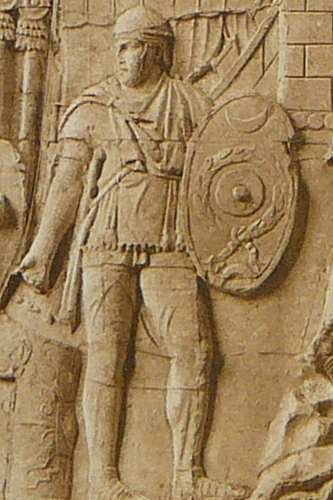
This page created 29 March 2014, and last modified: 21 November 2015 (Trajan's column picture added)

In the eastern half of the empire, the most senior of the 18 units of auxilia palatina listed (9.24 in Ingo Maier's numbering scheme) under the command of the first Master of the Soldiers in the Imperial Presence (i.e. the Magister Militum Praesentalis I) is the Batavi seniores. Its shield pattern (7#8) as shown in various manuscripts, under the matching label (7.h) Batavi seniores, is as below:


|
The pattern is depicted with a yellow boss bearing a spike (but with a white boss and blue spike in W); the boss is surrounded with a broad red band atop a red pillar forming a keyhole-like shape. The red keyhole shape is fimbriated (i.e. edged) with a light blue band (white in W) with an indigo fringe (purple in B, and absent in W). The main ground is light blue (yellow-orange in W), and the shield's rim is likewise light blue (but purple in B). A red crescent, positioned horns upward, appears in the 12 o'clock position, surmounted by a small charge, also in red, whose shape is unclear (note that the previously listed unit in the command, the Matiarii iuniores (9.22), has a small cross within the horns of its similarly-positioned crescent-moon emblem).
The motif of an upturned crescent in the 12 o'clock position as a shield emblem is carried by several other units in the Notitia, e.g. the Matiarii seniores (12.16). It is, however, not restricted to units depicted in the Notitia. To the left is my interpretation of a fresco painted on a wall of one of the catacombs of San Giovanni in Syracuse, Italy. A crescent with horns turned upward can be clearly made out on the soldier's shield; it is yellow in the original, albeit badly damaged by pitting (the main ground of the shield is white). The damage to the fresco makes it unclear what smaller charge is shown (if any) between and above the horns of the crescent. That the painting appears to accurately depict a soldier with equipment contemporary (or roughly contemporary) with the Notitia can be seen by looking at the helmet, which well depicts an "Intercisa"-style example. The San Giovanni shield pattern also shows a pillar beneath the boss (which is yellow, perhaps representing a copper alloy; the shield's rim is shown in the same colour); the pillar is a dark colour, perhaps purple, and there is some sort of flowing motif in yellow to the left and right of the boss that does not correspond well to any of the patterns found in the Notitia. |
|
Indeed, as a feature of shield patterns in the Roman army, the motif's history goes back to as least as far as Trajan's time, as several examples can be found on Trajan's column, one of which is shown on the right carried by what appears to be an auxiliary man. Crescents also appear as motifs found on units' standards, usually near the base, under round discs, and thus probably symbolising a sun-moon combination.
Two other units in the Notitia share the name Batavi seniores; one is a senior vexillationes palatinae unit under the Magister Equitum's Gallic command, the Equites Batavi seniores (102/5.6); while the other is the 6th-ranked auxilia palatina unit in the western half of the empire, and assigned (102/5.65) to the Magister Peditum's Italian command. The shield patterns of these three Batavi seniores units do not appear to have any close similarities; that of the eastern unit does however bear some resemblance to the next auxilia palatina unit listed under the Magister Militum Praesentalis I), the Brachiati iuniores (9.25), in terms of colour scheme and also having a spiked boss. An inscription (RIU 3,699 = CIL 3,10891; images here and here) from Hungary mentioning a T BAT has been expanded to "t(ribunus) Bat(avorum)", and is dated to 303. If the identification is correct, it shows the original Batavi auxilia palatina unit, like the Cornuti and the Regii, was one of the first of the auxilia palatina to be raised. When the unit was split between seniores and iuniores, and eastern and western units, and which split(s) came first, is not known for certain. In the history of Ammianus, "the" Batavi are found brigaded with "the" Heruli (20.1.3; 20.4.2; 27.1.6; 27.8.7; note that Latin does not have a demonstrative grammatical article corresponding to "the" in English...); and in the Notitia, the Heruli (seniores) (98/9.38), stationed in the west, is indeed followed (98/9.39) by a Batavi (seniores), so it would appear that the Heruli and Batavi pairing in Ammianus corresponds to the Notitia's Heruli seniores and (western) Batavi seniores. In his description of the battle of Adrianople (31.13.9), Ammianus has the Batavi there, as part of the eastern field army, and placed in reserve; they are not mentioned in conjunction with any other unit. This unit would appear to correspond to the eastern Batavi seniores, since Ammianus implies that its men had taken flight during the battle, and thus saved themselves from destruction. The absence of an eastern Batavi iuniores in the Notitia may imply it was destroyed at Adrianople, but the two apparent units of Batavi iuniores in the west requires caution to be taken in accepting this hypothesis. |

Detail from Trajan's column, scene 128. A Batavian auxiliary? |
The name Batavi is tribal, belonging to a Germanic group from what is now the Netherlands; they supplied the Roman army with many auxiliary units starting in the first century. In addition to the three units of Batavi seniores, several other units in the Notitia carry the name:
Equites Batavi iuniores (12.4), one of the vexillationes palatinae under the Magister Militum Praesentalis II;
Equites Batavi iuniores (102/5.10), one of the vexillationes palatinae in the Magister Equitum's Gallic command;
Batavi (iuniores) (102/5.123), in the Magister Equitum's Gallic command, and likely a unit of auxilia palatina;
Batavi iuniores (102/5.124), likely a unit of auxilia palatina and the same as the Britones in the Magister Equitum's Gallic command;
Cohors nova[e] Batavorum (147.12), a limitanei cohort under the Dux Raetiae primae et secundae;
Cohors prima Batavorum (154.23), a limitanei cohort under the Dux Britanniarum;
Laeti Batavorum et gentilium Suevorum (156/8.52), a "unit" of settlers in the area covered by the Magister Equitum's Gallic command;
Laeti Batavorum Nemetacensium (156/8.58), a "unit" of settlers under the Dux Belgicae secundae; and
Laeti Batavorum Contraginnensium (156/8.59), another "unit" of settlers under the Dux Belgicae secundae.
1. Ingo Maier; "Appendix 4: Numeration of the new edition of the compilation 'notitia dignitatum' (Cnd)"; last accessed 26 October 2015. See also for here for numbering examples. Return
2. Conrad Cichorius; "Die Reliefs der Traianssäule. Erster Tafelband: 'Die Reliefs des Ersten Dakischen Krieges'"; Berlin, Verlag von Georg Reimer (1886-1900); plate 96. Return
3. M.P. Speidel; "Raising New Units for the Late Roman Army"; Dumbarton Oaks Papers, 50 (1996), 163-170; available here (last accessed 21 November 2015). Return
4. Ammianus Marcellinus ("Ammianus"); "Res gestae a fine Corneli Taciti"; available here in Latin and here in English (last accessed 21 November 2015). Return

Return to the Notitia alphabetical unit list page.
Return to my Notitia index page.